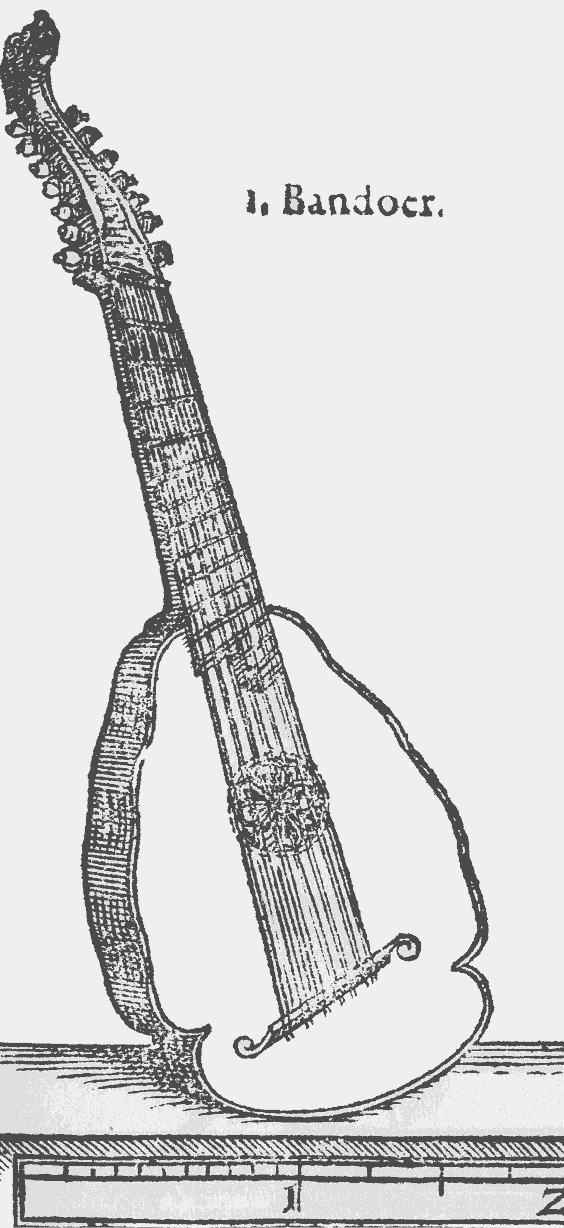
Bandora
Encyclopedia

Cittern
The cittern or cither is a stringed instrument dating from the Renaissance. Modern scholars debate its exact history, but it is generally accepted that it is descended from the Medieval Citole, or Cytole. It looks much like the modern-day flat-back mandolin and the modern Irish bouzouki and cittern...
though it does not have the "re-entrant" tuning typical of the cittern. Probably first built by John Rose in England around 1560, it remained popular for over a century. A somewhat smaller version was the orpharion
Orpharion
The orpharion or opherion is a plucked instrument from the Renaissance. It is part of the cittern family. Its construction is similar to the larger bandora. The metal strings are tuned like a lute and are plucked with the fingers. Therefore, the orpharion can be used instead of a lute...
.
Frequently one of the two bass instruments in a broken consort
Broken consort
A broken consort in English early Baroque musical terminology refers to ensembles featuring instruments from more than one family, for example a group featuring both string and wind instruments...
as associated with the works of Thomas Morley
Thomas Morley
Thomas Morley was an English composer, theorist, editor and organist of the Renaissance, and the foremost member of the English Madrigal School. He was the most famous composer of secular music in Elizabethan England and an organist at St Paul's Cathedral...
it is also a solo instrument in its own right. Anthony Holborne
Anthony Holborne
Anthony Holborne was a composer of English consort music during the reign of Queen Elizabeth I.-Life:Holborne entered Pembroke College, Cambridge in 1562. He was admitted to the Inner Temple Court in 1565. Holborne married Elisabeth Marten on 14 June 1584. On the title page of both his books he...
wrote many pieces for solo bandora. The multiple lute settings of Pacoloni appear both with and without optional wire-strung instruments.
Construction and type
The bandora, though built like a cittern, had six or seven courses (unison pairs) of strings tuned in a more luteLute
Lute can refer generally to any plucked string instrument with a neck and a deep round back, or more specifically to an instrument from the family of European lutes....
-like fashion, but without the high d found on a basslute. In fact, the barring is very close to an orpharion, and closer to contemporary lute than to cittern or guitar construction. This creates a proportion closer to present guitar tunings; typically C D G c e a, and occasionally a seventh low G string.
The term bandore and bandora were occasionally incorrectly applied to a Ukrainian folk instrument now more commonly known as the bandura
Bandura
Bandura refers to a Ukrainian plucked string folk instrument. It combines elements of a box zither and lute, as well as its lute-like predecessor, the kobza...
, an instrument with up to 68 strings that differs considerably from the bandora.
During the Renaissance times there were no naming conventions and terms were used loosely. The Spanish bandurria
Bandurria
The bandurria is a plectrum chordophone from Spain, similar to the cittern and the mandolin, primarily used in Spanish folk music.Prior to the 18th century, the bandurria had with a round back, similar or related to the mandore. It had become a flat-backed instrument by the 18th century, with five...
, though this term was once also interchangeable, now applies to a treble instrument like a mandolin
Mandolin
A mandolin is a musical instrument in the lute family . It descends from the mandore, a soprano member of the lute family. The mandolin soundboard comes in many shapes—but generally round or teardrop-shaped, sometimes with scrolls or other projections. A mandolin may have f-holes, or a single...
- a similar confusion as has occurred with mandore
Mandore (instrument)
The mandore was mentioned as a new instrument in French music books from the 1580s. It was a small member of the lute family, teardrop shaped, with four, five or six courses of gut strings and pitched in the treble range. It is considered ancestral to the modern mandolin and has also been called...
, mandora
Mandora
A mandora is a type of lute. The terms referred to different instruments at different periods in history.-Treble instrument:During the Renaissance, the term mandore was applied to the treble lute and in such usage it is difficult to distinguish from the mandola, the simple lute that is the ancestor...
, mandola
Mandola
The mandola or tenor mandola is a fretted, stringed musical instrument. It is to the mandolin what the viola is to the violin: the four double courses of strings tuned in fifths to the same pitches as the viola , a fifth lower than a mandolin...
(q.v.). All these instruments are thought to derive their names originally from the ancient pandura
Pandura
The pandura is an ancient Greek string instrument from the Mediterranean basin.It is derived from pandur, a Sumerian term for long-necked lutes...
(which term, once again, is found applied to a variety of stringed instruments in different regions at an early date).
External links
- Bandora, CS.Darthmouth.edu

